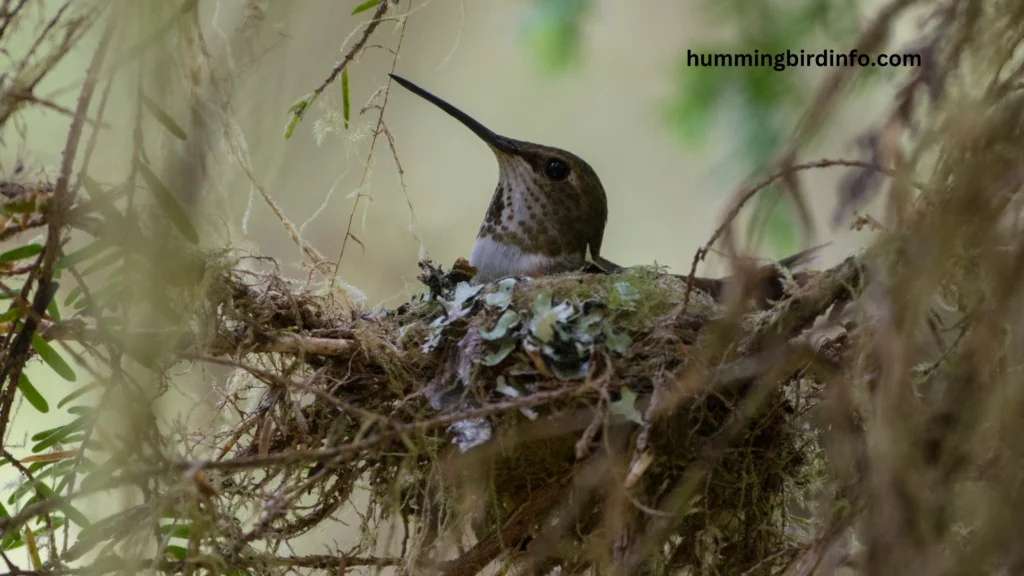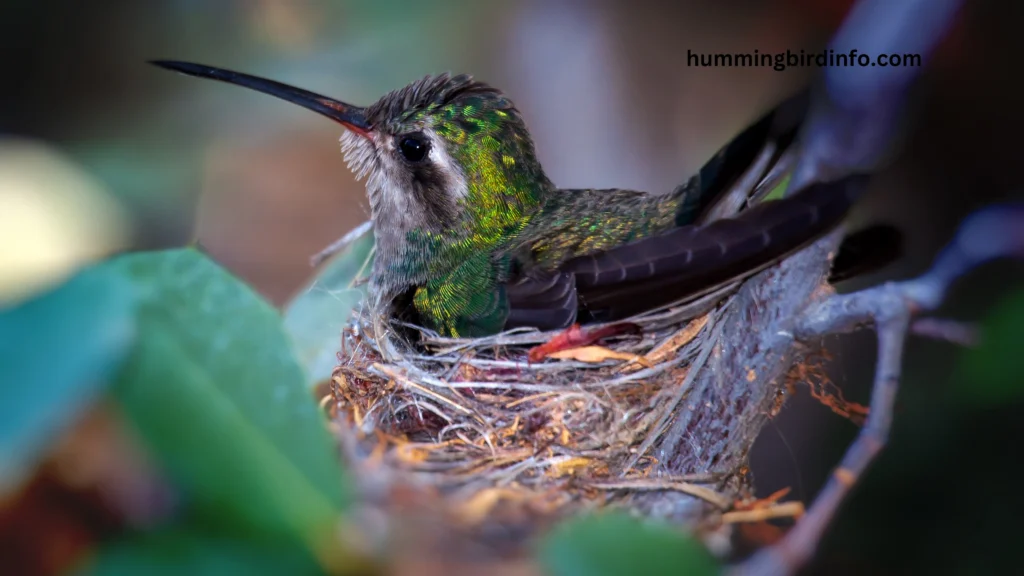In the quiet corners of gardens, forests, and meadows, tiny architects are hard at work crafting homes no bigger than a walnut. Hummingbird nests are delicate masterpieces, built with spider silk and soft plant fibers, perched on branches like living ornaments.
But while we admire these tiny nests, most people never stop to wonder—who builds them?
Unlike many bird species where both parents pitch in, hummingbirds follow a very different script. In nearly all species, it’s the female hummingbird alone who takes on this massive responsibility.
From choosing the right location to weaving together natural materials with astonishing precision, she does it all—while the male remains focused on singing, defending his territory, and seeking his next mate.
Why does she do it all by herself? What makes this solo act of motherhood such a defining trait in the hummingbird world? In this blog, we’ll explore not only which hummingbird builds the nest, but also the how, why, and what it reveals about their fascinating lives.
Whether you’re a backyard birdwatcher or just curious about nature’s most dedicated mothers, there’s much to marvel at in the quiet heroism of the female hummingbird.
Contents
1. The Unsung Heroine: The Female Hummingbird
Across more than 360 species, it is consistently the female hummingbird who constructs the nest, incubates the eggs, and raises the chicks without help.
After a brief mating encounter, the male disappears from the nesting equation, offering no assistance in parenting or protection.

The female embarks on her own, starting by selecting a strategically chosen site high in trees or shrubs to deter predators and withstand weather.
Nest placement is never random—she looks for proximity to nectar, safe camouflage in foliage, and shelter from wind or rain.
Some nests may even hang from slender branches or be tucked into the crook of a thorny bush for extra protection.
Importantly, no male hummingbird is ever involved in nest construction—his role ends at mating and territory defense.
This remarkable female behavior highlights a matriarchal strategy rooted in survival and efficiency.
While males focus on competition and courtship, females pour energy into nesting, laying, and chick-rearing.
Each nest is a solo mission, and every successful fledgling is a product of her resilience and skill.
2. The Art of Nest Construction: Materials and Techniques
The female collects plant down from milkweed, cattail, and thistle for softness and insulation.
Spider silk is her secret weapon—it binds materials, gives the nest flexibility, and lets it expand as chicks grow.
Moss, lichen, and leaves disguise the nest from predators, making it blend into the surroundings perfectly.
She starts by creating a foundation with twigs and fibers, securing it tightly with spider silk.
Then she sculpts the cup shape using her chest and body, pressing and molding it to size.
Layer after layer, she binds materials together to form a nest that’s strong, flexible, and well-hidden.
Outside, the nest is camouflaged with moss and bark bits—painstakingly attached for natural concealment.
Inside, she lines the nest with the softest materials, creating a cozy cradle for her tiny eggs.
The result is a resilient, elastic home that grows as the chicks inside do.
This process can take 5–10 days, requiring hundreds of trips to collect building materials.
Each trip is made with care, and every component is chosen for its role in warmth, strength, or disguise.
It’s a testament to the female’s persistence, intelligence, and instinctive craftsmanship.
3. The Size and Shape of a Mother’s Creation
A hummingbird nest is smaller than a golf ball—typically around 1 inch deep and just over an inch wide.
Its cup shape cradles the eggs snugly, preventing them from rolling and conserving warmth.
Despite its size, it’s engineered with the same precision as a cathedral.
Some variation in nest size occurs based on species and environment—larger hummingbirds build slightly bigger nests.
In warmer areas, nests may use fewer insulating materials, while cooler climates require more layering.
Regardless of region, the design stays compact and concealed for maximum protection.
In some cases, females may reuse old nests, reinforcing or rebuilding them with fresh material.
This saves time and energy, especially if food is scarce or the breeding season is short.
Such behavior showcases the adaptability and resourcefulness of these birds.
Even though the nest is often impossible to spot, it’s a bustling hub of activity during breeding season.
Eggs the size of jellybeans are carefully tucked inside this tiny fortress.
Within a few weeks, they hatch into chicks that rely entirely on the structure their mother created.
4. Evolutionary Reasons for Female Solo Nesting
Males invest their energy in territorial defense and attracting females through aerial displays.
They may mate with multiple females, making long-term parenting a costly strategy with no reproductive guarantee.
This mating system leads to female-only nesting responsibilities.
The female, on the other hand, is built for parental investment—from egg production to incubation.
She is specially adapted for resourceful, solitary parenting, ensuring the survival of her young.
Her nesting behavior reflects an evolutionary trade-off: quality care over quantity of mates.
By dividing roles, the species avoids redundancy and energy waste.
The male maximizes his mating success, while the female ensures offspring survival and development.
This balance boosts overall species fitness and reproductive success.
Predator avoidance also favors solo nesting—less traffic near the nest means less attention from threats.
With just one bird near the nest, the risk of detection drops dramatically.
This makes the female’s stealth and independence not only practical but essential.
Ultimately, this pattern of solo nesting evolved because it works—it aligns with their biology, environment, and reproductive goals.
It’s a system where both sexes do what they do best, ensuring continuity of the species.
The result: every chick owes its life to the effort of a single, determined mother.
5. Exceptions and Interesting Observations
To date, there are no widespread reports of male hummingbirds helping with nests.
They focus on display, defense, and dispersal, leaving the nest completely to the female.
Any exception to this rule is extremely rare or anecdotal in the wild.
Some hummingbirds have shown adaptive behaviors in urban environments.
They’ve used cotton, dryer lint, and even human hair in place of natural materials.
This shows remarkable flexibility in nest-building choices, especially near human habitats.
For birdwatchers hoping to spot a nest, stay respectful and distant.
Use binoculars, avoid touching or approaching active nests, and never trim vegetation near suspected sites.
These actions help protect the delicate work of the female and her future chicks.

Nests can be hard to find—often built in thorny bushes or shaded trees, perfectly camouflaged. But once seen, they offer an awe-inspiring look into the hummingbird’s maternal instinct and precision.
It’s a quiet marvel that many people never witness—but one that deserves deep respect.
Conclusion:
In the vibrant world of hummingbirds, it is the female alone who carries the weight of home-building.
From choosing a location to gathering materials and crafting a nest, she does it all with meticulous care.
Her work ensures the survival of her young and reflects millions of years of evolutionary wisdom.
This division of labor is no accident—it’s a strategic design, honed for reproductive success and predator avoidance.
Males play their part in spreading genes, while females ensure offspring thrive in the safest possible nests.
It’s a beautiful example of nature’s balance and efficiency.
So next time you spot a hummingbird zipping past, remember the unseen labor of the mother behind the scenes.
She’s more than a flier—she’s a builder, provider, and protector.
And in her tiny, woven cup lies the future of one of nature’s most dazzling wonders.
FAQs:
1. Do male hummingbirds help build the nest?
No, male hummingbirds do not participate in nest building, incubation, or chick-rearing.
2. How long does it take for a female hummingbird to build a nest?
It typically takes 5–10 days, depending on material availability and weather.
3. What materials do hummingbirds use for nests?
They use plant down, spider silk, moss, twigs, and occasionally animal hair or feathers.
4. How big is a hummingbird nest?
Most nests are about 1 to 1.5 inches in diameter—roughly the size of a golf ball.
5. Can a hummingbird reuse an old nest?
Yes, some females may reuse and reinforce old nests to save time and energy.
6. Why don’t males help with the nest?
Males focus on territory defense and mating, while females specialize in parental care.








